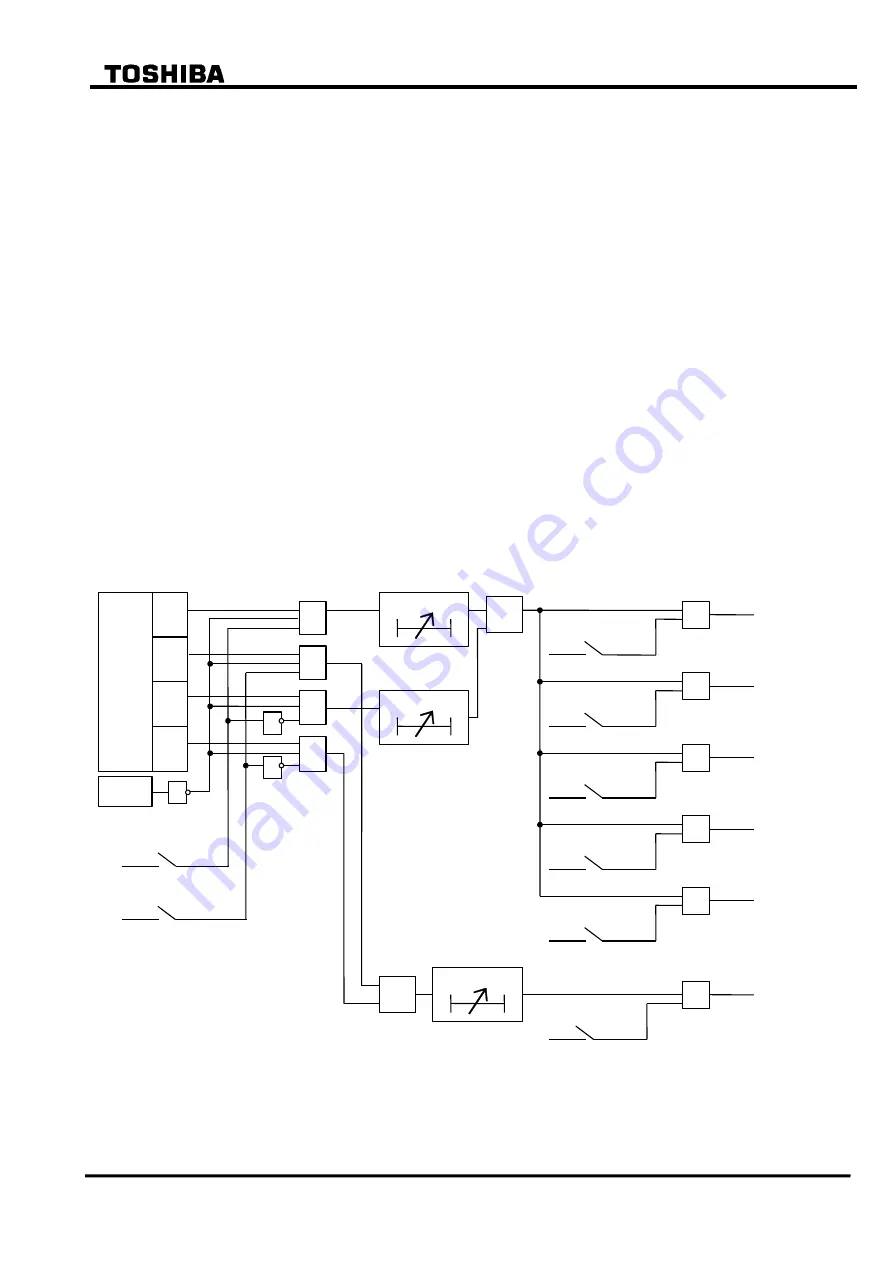
32
6
F
2
S
0
7
8
9
2.7 Frequency Protection
GRT100 provides an underfrequency or overfrequency protection and/or alarms for load
shedding or for detecting such an overfrequency condition caused by disconnecting load from a
particular generation location.
The frequency element FRQ comprises two frequency elements 81-1 and 81-2, the former is used
for tripping and the latter for alarms.
Figure 2.7.1 shows the scheme logic of frequency protection. The tripping element 81-1 outputs
underfrequency and overfrequency trip signals L1 and H1. Either underfrequency or
overfrequency protection is enabled by setting the scheme switch [FRQ-UF1] to “ON” or “OFF”.
The alarm element 81-2 outputs underfrequency and overfrequency alarm signals L2 and H2.
Either underfrequency or overfrequency alarms are enabled by setting the scheme switch
[FRQ-UF2] to “ON” or “OFF”.
Frequency protection can perform time-delayed tripping of up to five breakers. Any of the
breaker tripping signals FRQ-1 to FRQ-5 can be blocked by the scheme switch [FRQ1] to
[FRQ5] settings.
Alarm signal FRQ-A can be blocked by the scheme switch [FRQA] setting.
Frequency protection is blocked under the condition that the system voltage is lower than the
setting of the undervoltage element UV.
FRQ-1
1
1
TFRQL
0.00 - 60.00s
&
&
&
&
TFRQH
0.00 - 60.00s
0.00 - 60.00s
FRQ-2
FRQ-3
FRQ-4
FRQ-5
FRQ-A
[FRQA]
&
TFRQA
[FRQ1]
&
[FRQ2]
&
[FRQ3]
&
[FRQ4]
&
&
1
1
[FRQ5]
0
t
0
t
0
t
FRQ-UF1
FRQ-UF2
81-1
81-2
H1
H2
L2
L1
UV
1
“ON”
“ON”
“ON”
“ON”
“ON”
“ON”
“ON”
“ON”
FRQ
Figure 2.7.1 Scheme Logic of Frequency Protection
Summary of Contents for GRT100 Series
Page 142: ... 141 6 F 2 S 0 7 8 9 Appendix A Block Diagram ...
Page 144: ... 143 6 F 2 S 0 7 8 9 Appendix B Signal List ...
Page 159: ... 158 6 F 2 S 0 7 8 9 ...
Page 160: ... 159 6 F 2 S 0 7 8 9 Appendix C Variable Timer List ...
Page 162: ... 161 6 F 2 S 0 7 8 9 Appendix D Binary Output Default Setting List ...
Page 165: ... 164 6 F 2 S 0 7 8 9 ...
Page 166: ... 165 6 F 2 S 0 7 8 9 Appendix E Details of Relay Menu and LCD and Button Operation ...
Page 174: ... 173 6 F 2 S 0 7 8 9 Appendix F Case Outline Flush Mount Type Rack Mount Type ...
Page 179: ... 178 6 F 2 S 0 7 8 9 ...
Page 180: ... 179 6 F 2 S 0 7 8 9 Appendix G External Connections ...
Page 185: ... 184 6 F 2 S 0 7 8 9 ...
Page 200: ... 199 6 F 2 S 0 7 8 9 ...
Page 201: ... 200 6 F 2 S 0 7 8 9 Appendix J Return Repair Form ...
Page 205: ... 204 6 F 2 S 0 7 8 9 Customer Name Company Name Address Telephone No Facsimile No Signature ...
Page 206: ... 205 6 F 2 S 0 7 8 9 ...
Page 207: ... 206 6 F 2 S 0 7 8 9 Appendix K Technical Data ...
Page 220: ... 219 6 F 2 S 0 7 8 9 ...
Page 221: ... 220 6 F 2 S 0 7 8 9 Appendix M Symbols Used in Scheme Logic ...
Page 224: ... 223 6 F 2 S 0 7 8 9 ...
Page 225: ... 224 6 F 2 S 0 7 8 9 Appendix N Implementation of Thermal Model to IEC60255 8 ...
Page 228: ... 227 6 F 2 S 0 7 8 9 ...
Page 229: ... 228 6 F 2 S 0 7 8 9 Appendix O IEC60870 5 103 Interoperability and Troubleshooting ...
Page 241: ... 240 6 F 2 S 0 7 8 9 Appendix P Modbus Interoperability ...
Page 255: ... 254 6 F 2 S 0 7 8 9 ...
Page 256: ... 255 6 F 2 S 0 7 8 9 Appendix Q Inverse Time Characteristics ...
Page 259: ... 258 6 F 2 S 0 7 8 9 ...
Page 260: ... 259 6 F 2 S 0 7 8 9 Appendix R Failed Module Tracing and Replacement ...
Page 266: ... 265 6 F 2 S 0 7 8 9 Appendix S Ordering ...
Page 269: ... 268 6 F 2 S 0 7 8 9 3 1 Oct 2 2017 Republished under spin off company ...
Page 270: ......
















































